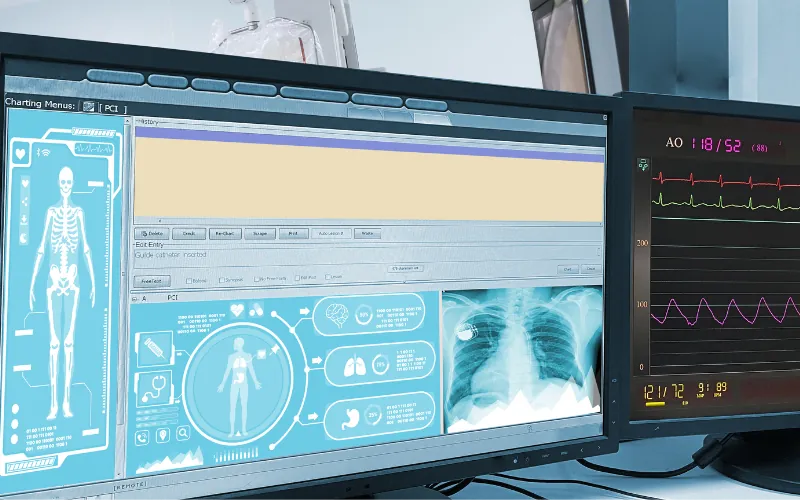Right heart failure (RHF) in pulmonary hypertension refers to the inability of the right side of the heart to effectively pump blood through the pulmonary circulation due to increased pressure within the pulmonary arteries. Pulmonary hypertension, characterized by elevated blood pressure in the pulmonary arteries, imposes a significant strain on the right ventricle, leading to progressive damage and dysfunction. As the disease advances, the right ventricle becomes increasingly unable to cope with the increased workload, resulting in impaired cardiac output and circulation.
This article explores various medical interventions aimed at addressing the complex interplay between pulmonary vascular disease and right ventricular dysfunction. Additionally, we delve into the revolutionary potential of Remote Patient Monitoring (RPM) in transforming the management of pulmonary hypertension and right heart failure.
What is Pulmonary Hypertension (PH)?
Pulmonary hypertension refers to a hemodynamic disorder defined by an elevated mean pulmonary arterial pressure (mPAP) of 20 mmHg or greater at rest, as measured by right heart catheterization. This condition can result from various underlying causes, including pulmonary arterial hypertension (PAH), left heart disease, lung diseases, chronic thromboembolic disease, and other less common conditions.
The connection between PH and RHF underscores the importance of early detection and aggressive management of PH to prevent or delay the progression to right heart failure. Effective treatment strategies targeting both pulmonary vascular disease and right ventricular dysfunction are essential for improving outcomes and enhancing the quality of life for individuals with this challenging condition.

Understanding Right Heart Failure in Pulmonary Hypertension
Managing diabetes incontinence often begins with adopting healthy lifestyle habits that can help alleviate symptoms and improve bladder control. These lifestyle changes can complement other treatment modalities and contribute to overall well-being. Here are some effective strategies:
Pathophysiology and Mechanisms
- Hemodynamic Changes: In pulmonary hypertension, increased pulmonary vascular resistance (PVR) leads to elevated pressure within the pulmonary circulation. This elevated pressure imposes a significant afterload on the right ventricle, causing it to work harder to pump blood into the pulmonary arteries. Over time, this increased workload can lead to right ventricular hypertrophy (RVH) and eventually, right ventricular failure.
- Myocardial Remodeling: The chronic pressure overload on the right ventricle results in structural changes within the myocardium. These changes include myocardial hypertrophy, fibrosis, and alterations in gene expression, all of which contribute to impaired right ventricular function.
- Neurohormonal Activation: The development of right heart failure in pulmonary hypertension is associated with the activation of various neurohormonal pathways, including the sympathetic nervous system, renin-angiotensin-aldosterone system (RAAS), and endothelin system. These neurohormonal changes contribute to vasoconstriction, sodium, and water retention, and further myocardial remodeling, exacerbating right ventricular dysfunction.
Clinical Manifestations and Symptoms
- Progressive Dyspnea: Dyspnea on exertion is often the earliest symptom of right heart failure in pulmonary hypertension. As the disease progresses, dyspnea may occur at rest and be accompanied by orthopnea and paroxysmal nocturnal dyspnea.
- Fatigue and Exercise Intolerance: Reduced cardiac output and impaired oxygen delivery to tissues lead to fatigue and exercise intolerance in individuals with right heart failure. Patients may experience difficulty performing routine activities and may become increasingly sedentary.
- Fluid Retention and Peripheral Edema: Right heart failure can lead to fluid retention, resulting in peripheral edema, ascites, and hepatic congestion. Jugular venous distention may also be present due to elevated central venous pressure.
- Cyanosis and Syncope: Severe right heart failure may manifest as cyanosis due to reduced oxygen saturation in peripheral tissues. Syncope can occur secondary to reduced cardiac output and cerebral hypoperfusion.
Understanding the pathophysiological mechanisms and clinical manifestations of right heart failure in pulmonary hypertension is essential for timely diagnosis and appropriate management. Early recognition and intervention can help mitigate disease progression and improve outcomes for affected individuals.

Diagnostic Tools for Assessing Right Heart Failure in PH
Echocardiography
- Transthoracic Echocardiography (TTE): TTE is a non-invasive imaging modality widely used for the assessment of right heart function in pulmonary hypertension. It provides valuable information about right ventricular size, function, and geometry, as well as estimates of pulmonary artery pressures and right atrial pressure.
- Doppler Echocardiography: Doppler echocardiography allows for the assessment of tricuspid regurgitation velocity, which can be used to estimate pulmonary artery systolic pressure (PASP). Additionally, tissue Doppler imaging can provide insights into right ventricular systolic and diastolic function.
Cardiac Catheterization
- Right Heart Catheterization (RHC): RHC remains the gold standard for the diagnosis and hemodynamic assessment of pulmonary hypertension. It involves the insertion of a catheter into the right heart chambers and pulmonary artery to directly measure pressures and assess cardiac output.
- Pulmonary Artery Wedge Pressure (PAWP): PAWP measurement helps differentiate between pre-capillary and post-capillary causes of pulmonary hypertension. In patients with right heart failure, PAWP may be elevated, indicating left heart dysfunction as a contributing factor.
Biomarkers
- Brain Natriuretic Peptide (BNP) and N-terminal pro-BNP (NT-proBNP): BNP and NT-proBNP are cardiac biomarkers released in response to myocardial stretch and pressure overload. Elevated levels of these biomarkers are associated with right ventricular dysfunction and may aid in the diagnosis and prognostication of right heart failure in pulmonary hypertension.
- Troponin: Elevated troponin levels may indicate myocardial injury or ischemia, which can occur in the setting of right heart failure and contribute to adverse outcomes.
Diagnostic tools such as echocardiography, cardiac catheterization, and biomarkers play a crucial role in the assessment and monitoring of right heart failure in pulmonary hypertension. These modalities provide valuable information for risk stratification, treatment planning, and evaluation of treatment responses in affected individuals.

Medical Management of Right Heart Failure in Pulmonary Hypertension
In addition to medications and lifestyle changes, behavioral therapies offer effective strategies for managing diabetes incontinence by addressing bladder control and promoting healthy voiding habits. These therapies focus on retraining the bladder and improving voluntary control over urinary function. Here are some key behavioral therapies:
Pharmacological Interventions
- Diuretics: Diuretics are commonly used to manage fluid retention and reduce volume overload in patients with right heart failure. Loop diuretics such as furosemide are often employed to promote diuresis and alleviate symptoms of congestion.
- Vasodilators: Vasodilator therapy aims to reduce pulmonary vascular resistance (PVR) and alleviate the workload on the right ventricle. Agents such as calcium channel blockers, endothelin receptor antagonists (ERAs), and phosphodiesterase-5 (PDE-5) inhibitors may be used to achieve vasodilation and improve hemodynamics.
- Inotropic Agents: Inotropic agents such as dobutamine and milrinone may be utilized in cases of acute decompensated right heart failure to enhance myocardial contractility and improve cardiac output. However, their long-term use in chronic heart failure is limited due to concerns regarding adverse effects and lack of survival benefit.
Oxygen Therapy
Supplemental oxygen therapy is often prescribed to improve oxygenation and alleviate hypoxemia in patients with pulmonary hypertension and right heart failure. Adequate oxygenation is crucial for optimizing cardiac function and reducing pulmonary vasoconstriction.
Anticoagulation
Anticoagulation therapy may be considered in select patients with pulmonary hypertension to reduce the risk of thromboembolic events, particularly in the setting of underlying thrombotic disease or atrial arrhythmias. However, the use of anticoagulants should be carefully balanced with the risk of bleeding complications.
Effective medical management of right heart failure in pulmonary hypertension requires a comprehensive approach targeting both pulmonary vascular disease and right ventricular dysfunction. Pharmacological interventions aimed at reducing fluid overload, decreasing pulmonary vascular resistance, and improving cardiac function play a central role in symptom management and disease progression.

Surgical and Interventional Approaches
Right Heart Catheterization and Balloon Pulmonary Angioplasty
- Right Heart Catheterization (RHC): In addition to its diagnostic utility, RHC can serve as a therapeutic intervention in pulmonary hypertension. Pulmonary vasodilator agents, such as prostacyclin analogs or nitric oxide, can be administered directly into the pulmonary circulation via catheterization to achieve selective vasodilation and improve hemodynamics.
- Balloon Pulmonary Angioplasty (BPA): BPA is a minimally invasive procedure performed in specialized centers for the treatment of chronic thromboembolic pulmonary hypertension (CTEPH). It involves the use of balloons to dilate stenotic or occlusive lesions within the pulmonary arteries, thereby improving pulmonary blood flow and relieving right ventricular pressure overload.
Lung Transplantation
Lung transplantation may be considered in patients with advanced pulmonary hypertension and refractory right heart failure who fail to respond to medical therapy. Lung transplantation offers the potential for long-term survival and improvement in quality of life by replacing the diseased lungs with healthy donor lungs. However, transplantation candidacy is contingent upon strict criteria, including disease severity, functional status, and absence of contraindications.
Surgical and interventional approaches play a critical role in the management of right heart failure in pulmonary hypertension, particularly in cases of advanced disease or specific etiologies such as chronic thromboembolic pulmonary hypertension. These interventions aim to alleviate pulmonary vascular obstruction, reduce right ventricular afterload, and improve cardiac function, thereby enhancing symptoms and prognosis.
Lifestyle Modifications and Supportive Care
Exercise Rehabilitation
- Supervised Exercise Training: Structured exercise programs supervised by healthcare professionals can improve exercise capacity, functional status, and quality of life in patients with pulmonary hypertension and right heart failure.
- Pulmonary Rehabilitation: Pulmonary rehabilitation programs, which encompass exercise training, education, and psychosocial support, can help optimize respiratory function, alleviate dyspnea, and enhance overall well-being.
Nutritional Counseling
Nutritional support and counseling are essential components of comprehensive care for patients with pulmonary hypertension and right heart failure. A balanced diet rich in fruits, vegetables, lean proteins, and whole grains can promote overall health and support cardiovascular function. Sodium restriction may be recommended to reduce fluid retention and minimize symptoms of congestion.
Psychosocial Support
Living with pulmonary hypertension and right heart failure can pose significant emotional and psychological challenges for patients and their caregivers. Psychosocial support services, including counseling, support groups, and educational resources, can provide valuable emotional support, coping strategies, and assistance with disease management.
Adopting healthy lifestyle habits and receiving supportive care are integral aspects of managing pulmonary hypertension and right heart failure beyond medical and surgical interventions. Lifestyle modifications, including regular exercise, healthy eating habits, and psychosocial support, can complement medical therapy, improve symptom control, and enhance the overall quality of life for patients and their families.
Optimizing Treatment Strategies with DrKumo’s RPM Solution
In the realm of managing right heart failure in pulmonary hypertension, incorporating innovative solutions like RPM can revolutionize patient care. DrKumo, a leader in RPM technology, offers a comprehensive platform that empowers healthcare providers to remotely monitor vital signs and symptoms associated with pulmonary hypertension and right heart failure.
Through DrKumo’s RPM system, patients can receive real-time feedback on their condition, enabling early detection of worsening symptoms and timely intervention. This proactive approach not only improves patient outcomes but also enhances patient engagement and satisfaction by providing personalized and accessible care.
By integrating DrKumo’s RPM solution into the management of pulmonary hypertension and right heart failure, healthcare providers can optimize treatment strategies, minimize hospitalizations, and ultimately, improve the overall quality of life for patients affected by these complex conditions.
Frequently Asked Questions
What are the main medical treatments for right heart failure in pulmonary hypertension?
The main medical treatments include pharmacological interventions such as diuretics, vasodilators, and inotropic agents to alleviate symptoms and improve cardiac function. Additionally, lifestyle modifications and supportive care play a crucial role in managing the condition.
How can RPM benefit individuals with pulmonary hypertension and right heart failure?
RPM offers a transformative approach to patient care by enabling remote monitoring of vital signs and symptoms, facilitating early detection of complications, and optimizing treatment adjustments. This proactive approach enhances patient engagement and satisfaction while improving outcomes.
What role do surgical and interventional approaches play in the management of right heart failure in pulmonary hypertension?
Surgical and interventional approaches, such as right heart catheterization and balloon pulmonary angioplasty, can alleviate pulmonary vascular obstruction and reduce right ventricular afterload, thereby improving cardiac function and symptoms.
How do lifestyle modifications contribute to managing right heart failure in pulmonary hypertension?
Lifestyle modifications, including exercise rehabilitation, nutritional counseling, and psychosocial support, complement medical therapy by promoting overall well-being, optimizing respiratory function, and enhancing the quality of life for patients and their families.
What emerging therapies and research directions hold promise for the treatment of right heart failure in pulmonary hypertension?
Emerging therapies such as novel pharmacological agents, gene therapy, and stem cell transplantation offer exciting prospects for addressing underlying disease mechanisms and improving outcomes. Ongoing research efforts aim to translate these innovative interventions into clinical practice for the benefit of patients worldwide.
Takeaways
The management of right heart failure in pulmonary hypertension is multifaceted, requiring a comprehensive approach that integrates pharmacological, surgical, lifestyle, and emerging therapeutic strategies. Understanding the pathophysiological mechanisms underlying right heart failure and its connection to pulmonary hypertension is crucial for guiding treatment decisions and optimizing outcomes.
Incorporating RPM into the management of right heart failure in pulmonary hypertension not only enhances patient engagement but also enables more personalized and proactive approaches to treatment. With RPM, patients can receive continuous support, guidance, and monitoring, leading to better outcomes and an improved quality of life. Embracing RPM alongside conventional medical approaches underscores a commitment to delivering comprehensive and patient-centered care in the management of pulmonary hypertension and right heart failure.
Ready to take control of your pulmonary hypertension and right heart failure management? Contact DrKumo today to learn more about how RPM can revolutionize your care. Visit our Contact Page at https://drkumo.com/contact-us/ to get in touch with our team and start your journey towards better health.
Disclaimer: The information provided is for educational and informational purposes only. It is not intended to be a substitute for professional medical advice, diagnosis, or treatment.








